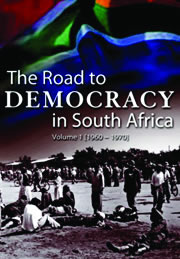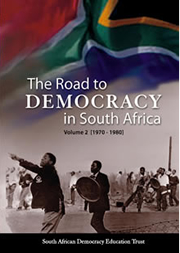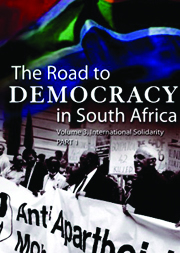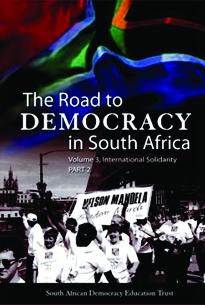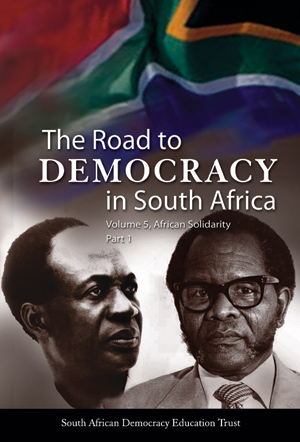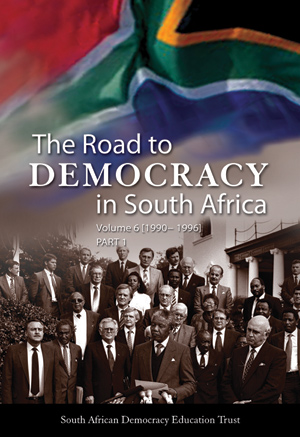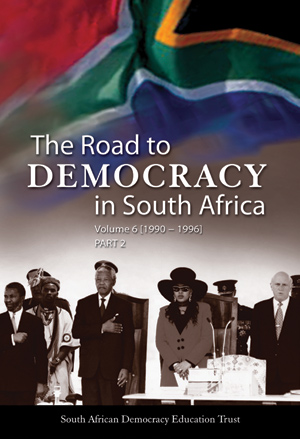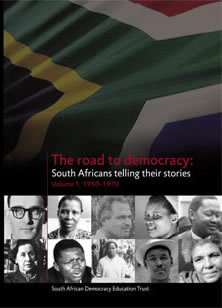The Road to Democracy in South Africa, Volume 4 part 1 and 2, 1980–1990
Pretoria, UNISA Press, 2010.
Also available through International Specialized Book Services (ISBS) in the United States of America and Eurospan Bookstore in Europe.
South African Democracy Education Trust
In the tortured history of the struggle for national liberation in South Africa, the 1980s will go down as one of the most critical decades. It not only saw the mobilisation of the popular masses but also the marked escalation of the armed struggle inside the country, initiated and waged by the African National Congress (ANC). It witnessed cracks in the edifice of the National Party regime; and among the oppressed it saw the birth of the United Democratic Front (UDF) and the Congress of South African Trade Unions (COSATU). The liberation movement, headed by the ANC-led Congress Alliance, took major strides which finally broke the backbone of white supremacist rule. By the 1980s the noose was tightening around the apartheid regime and this heightening pressure is discussed closely in chapter 1, ‘The Crisis of the Garrison State’, written by international scholar, Bernard Magubane.
Chapter 2, authored by Sifiso Ndlovu, unravels the negotiations in which the exiled ANC became involved in the 1980s. These included talks in mid-decade with big business and the Progressive Federal Party (PFP) and a meeting in Dakar some two years later with fifty white and coloured intellectuals with anti-apartheid leanings. The ANC also consulted with the Organisation of African Unity (OAU), which led in turn to a concerted move to hold active talks with the trade unions, the UDF, the churches and other relevant democratic bodies on the adoption of a common position on negotiations. After the adoption of the Harare Declaration in 1989, by which time the apartheid regime was tottering, there were persistent ANC calls for substantive negotiations to form an interim government in South Africa and the election of a constituent assembly.
In the chapter that follows, chapter 3, Gregory Houston provides a lucid account of the organisation of the ANC underground in the 1980s, a decade in which it achieved its goal to mobilise the masses to participate in the liberation struggle. The chapter answers a number of crucial questions, including: What were the main objectives of the ANC’s underground political work inside the country? What structures and which individuals were responsible for conducting underground political work? What was the relationship between clandestine underground political work and aboveground organisation and activity? What were the main strategies used by underground political activists?
Linking up with the previous chapter, but with a particular geographical focus, the next three chapters were all written by Jabulani Sithole. They provide a comprehensive assessment of the ANC underground, armed actions and popular resistance in the 1980s in the Natal Midlands (chapter 4); Northern Natal (chapter 5) and Southern Natal (chapter 6). Backed by careful analysis of primary sources, Sithole refutes the claims that the widespread community struggles were spontaneous outbursts and that exiled-based ‘hit-and-run units’ were solely responsible for waging the ANC’s armed struggle. He argues incisively that the ANC underground in Natal was both well organised and effective; and that there were indeed links between the issue-driven community struggles and the ANC’s underground activities.
Chapters 7 and 8 turn to the liberation struggle in the 1980s in the Eastern Cape, beginning with Janet Cherry’s discussion of the ‘hidden histories’ of the underground in that region, the moving accounts of those involved – stories that until now have remained untold. Her chapter is well complemented by the one that follows, written by Pat Gibbs: ‘Race and Ideology in Port Elizabeth: A View from the Northern Areas, 1979–1990’, which focuses on the struggle waged from the workplace, particularly the resistance shown by coloured activists in the PE/Uitenhage region. Gibbs points out that the 1980s became a time of rebuilding peaceful, aboveground, mass organisations such as civics, trade unions, women’s organisations, and youth and student movements on a Congress-aligned basis. Nowhere were these more powerful and effective than in the Eastern Cape. These organisations were often initiated by ANC underground cells or worked in tandem with them, but it was the organisations themselves which gained power for change through peaceful protest, stayaways, strikes and boycotts. The chapter investigates the race and class components of these bodies and how they interrelated; it also looks at the intersections between black and coloured activism in the trade unions.
The focus then shifts to the countrywide ‘umbrella’ influence of the UDF, the major anti-apartheid formation within the country in the 1980s. In chapter 9, ‘The United Democratic Front in Cape Town, 1983–1986’, Jeremy Seekings discusses the UDF’s role from its formation in 1983. He shows how it drew local and regional organisations together into nationwide campaigns and co-ordination; and explains how it mobilised an impressive interplay of national concerns and activities with regional and local political dynamics. He goes on to discuss some of the UDF’s underlying weaknesses and great strengths as a vehicle which carried the liberation struggle forward at a time when the edifice of the apartheid regime was crumbling but the ANC was still banned in South Africa.
Following this, in chapter 10, Sekibakiba Lekgoathi continues on a similar theme. His chapter focuses on the nature of UDF organisation and its influence on the upheavals that took place in the Vaal Triangle and the West Rand townships during the 1980s. The surge of political unrest in the PWV area began in 1984 and by April tens of thousands of students from schools across the country were boycotting classes. By June they had joined forces with community organisations and workers’ unions in protesting against increased rents and service charges; and by August the protests were also directed at the regime’s tri-cameral parliamentary elections. In the Vaal Triangle massive violence flared up in September during a one-day stayaway. The insurrection spread like wildfire throughout the townships and even reached the rural villages. The number of deaths spiralled and in a desperate effort to control the violence the regime declared a state of emergency in the PWV and Eastern Cape.
The UDF in Lebowa and KwaNdebele during the 1980s is examined in chapter 11, which is also compiled by Lekgoathi. He maintains that the mid 1980s was a turning point in the conduct of politics waged within rural communities. Taking the Bantustans of Lebowa and KwaNdebele as case studies, he shows that for the first time young people from the rural areas occupied a central position in political struggles. Under the direct and indirect influence of the UDF and aligned organisations, the young ‘comrades’ often embarked on campaigns independently of established organisations. He argues that their activities had a significant impact on the political landscape of the decade.
Andrew Manson and Bernard Mbenga are the co-authors of chapter 12, which explores activities in Bophuthatswana in the 1980s and looks at the role of the UDF in the Western Transvaal. They show that by the 1980s Lucas Mangope had effectively installed a rule of fear in the region and became increasingly autocratic, surrounding himself with a small coterie of trusted supporters and family members. In addition, the Bophuthatswana police and army, backed by those of the apartheid regime, became an extension of his personal priorities and impulses. He proceeded to crush all opposition to his rule, including that at the University of Bophuthatswana. In 1988 the coup attempt against the Mangope regime was put down by the heavy hand of Pretoria. The UDF was not banned in Bophuthatswana during the 1980s but was strenuously curtailed; South African trade unions were also muzzled, although his did not prevent clandestine organisation or illegal striking. Importantly, the ANC made use of Bophuthatswana as a corridor between Botswana and South Africa and the area continued to be a site of MK activity throughout the decade.
Chapter 13, written by Chitja Twala and the late Leo Barnard, has a different focus but dovetails to some extent with the previous four chapters as far as the backing of the UDF is concerned. It explores the underlying reasons behind popular resistance in the Northern Cape in the 1980s. The authors explain that although it is sometimes argued that the region made no major contribution to the liberation struggle, there was indeed mass involvement of the communities in the province despite its small and scattered population. In this chapter the particular focus falls on activists in the coloured and African communities. And in chapter 14, Jeremy Seekings collaborates with Chitja Twala to examine activist networks and political protest in the Free State. The authors explain that although no regional UDF structure was ever formally launched in the area there were protests in the townships of Tumahole, Thabong (Welkom) and Mangaung (Bloemfontein); these later spread as far afield as Bethlehem and Harrismith. Chapter 15, by Chitja Twala, then looks at resistance and conformity in the Qwaqwa homeland, where most political resistance revolved around the authoritarianism of the homeland government, its lack of accountability, and demands that the Bantustan system be scrapped. The author also explains that late in the decade there was unprecedented political radicalisation among broad sections of the working class in this area.
Chapters 16 and 17 both focus on trade unionism. In Chapter 16 Jabulani Sithole explores the activities of the South African Congress of Trade Unions (SACTU) and labour struggles in South Africa and overseas during the 1980s. It looks at a number of crucial issues, including SACTU’s efforts to re-structure itself and re-locate its operational headquarters between Lusaka and to Dar es Salaam; the activities of SACTU’s internal committees; the establishment of its hegemony within the South African labour movement between 1984 and 1988; and SACTU’s activities in Canada, Western Europe, Australia, New Zealand and elsewhere in Africa. Finally, in a discussion that links chapter 16 to the next chapter, it looks at developments which preceded the decision to forge close ties between SACTU and COSATU. Chapter 17, compiled by Sifiso Ndlovu and Jabulani Sithole, then takes up the discussion. It assesses the trade union unity summits held in the 1980s, showing how these initiatives eventually laid the basis for the disbanding of SACTU and the absorption of its personnel into COSATU in 1990.
Taking a refreshingly different theme, chapter 18 looks at the broad sweep of the arts in the 1980s, and is the work of Bhekizizwe Peterson. He argues that in this decade the arts were informed and stimulated by the political commitment and resilience of artists in the face of mounting state repression. A range of new or re-constituted social movements arose – such as the community art centres that operated under the banner of the Mass Democratic Movement (MDM) and the labour movement. Peterson also maintains that the sport and cultural boycott was probably the crucial element in campaigns to isolate the apartheid state. The cultural boycott, designed to expose the regime as a pariah state in the global artistic and sporting arenas, also forged solidarity between local and international artists. Developments in literature, music, theatre, writing, documentary photography and the performing arts in the ‘perilous times’ of the 1980s are all discussed.
In an incisive chapter entitled ‘Attitudes towards Feminism among Women in the ANC, 1950–1990: A Theoretical Re-interpretation’, Zine Magubane explains in chapter 19 that many women who supported the ANC prioritised the struggle for national liberation over that for women’s emancipation. She shows why ‘motherism’ became such an important mobilisation strategy and goes on to examine whether and in what form ANC women addressed sexism within their own families and communities as well as in the struggle. Other very pertinent issues that are addressed include whether or not ANC women articulated a knowledge of sexism within these arenas; how they interpreted and explained sexism; and what type of future society they envisioned building. This chapter also looks at the impact of women on the national liberation struggle. Specifically, it asks: Did women tend to become more conservative when they entered the national liberation struggle? Did they tend to become radicalised? And what impact did their attitudes have on the course and trajectory of the national liberation struggle?
Gregory Houston is the author of chapter 20, ‘The ANC’s Armed Struggle in the 1980s’, which shows in great detail how the 1980s became a decade during which military operations inside the country were stepped up. He discusses the strategic documents that guided the conduct of the ANC’s armed struggle and the corresponding changes that were wrought in military policy. The chapter also looks at the various command structures and individuals responsible for conducting the armed struggle, and some of the structural, operational and regional political problems that cropped up. MK’s key operations during the decade and the major acts of sabotage that were undertaken are also outlined. The chapter ends with a useful reference aid: a full list of MK operations from 1976 to 1980, based on TRC hearings and other reputable ANC primary documents.
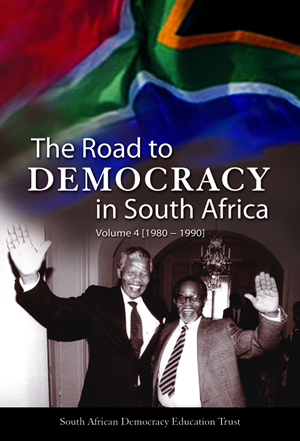 Chapter 21, written by Eddy Maloka discusses the fortunes of the SACP in the 1980s. He points out that by the 1980s the Party’s strategy focused on building a strong underground presence inside the country, particularly among the working class. The decade saw the stabilisation of the structures of the Party in a number of areas including finances, improvement of propaganda and increased membership. As for its collaborative relations with the ANC, Maloka shows that although the SACP was determined to influence the direction of the ANC the relationship between them was more dynamic than some have argued. The ANC, for its part, and largely thanks to the purposeful leadership of O.R. Tambo, ensured that it was by no means controlled by the SACP, and that the ANC remained independent as a nationalist movement that took the lead in the liberation of the oppressed masses.
Chapter 21, written by Eddy Maloka discusses the fortunes of the SACP in the 1980s. He points out that by the 1980s the Party’s strategy focused on building a strong underground presence inside the country, particularly among the working class. The decade saw the stabilisation of the structures of the Party in a number of areas including finances, improvement of propaganda and increased membership. As for its collaborative relations with the ANC, Maloka shows that although the SACP was determined to influence the direction of the ANC the relationship between them was more dynamic than some have argued. The ANC, for its part, and largely thanks to the purposeful leadership of O.R. Tambo, ensured that it was by no means controlled by the SACP, and that the ANC remained independent as a nationalist movement that took the lead in the liberation of the oppressed masses.
Chapters 22 and 23 form an interactive unit. Both were written by Thami ka Plaatjie and deal with the PAC’s activities in the 1980s – first the organisation’s exile politics; and then its attempts at internal revival. The decade did not begin well for the exiled PAC, because the organisation was beset by internal division. Despite this the organisation survived and moved ahead. The escalation of conflict between the regime and PAC cadres inside South African increased and this created fertile ground for the resurgence of APLA. The first initiatives to infiltrate cadres into the country took place at the end of 1981. Meanwhile, as shown in chapter 23, there was a crop of radicalised youth and politicised people with PAC leanings; a generation of young leaders was on the rise to fill the senior roles that had been lost to the PAC because its leaders were languishing in prison. Gradually there was a revival of the PAC underground and a re-organisation of its cadres who were lying low for fear of arrest. The emergence of a revolutionary trade union movement that led to the formation of the National Council of Trade Unions (NACTU) also influenced the revival of the PAC in the 1980s.
Two essays on Black Consciousness-aligned movements are provided in chapters 24 and 25, both written jointly by Mbulelo Vizikhungo Mzamane and Bavusile Maaba. Chapter 24 discusses the fortunes of the Azanian People’s Organisation (AZAPO) which was formed in 1978 after the massive crackdown on virtually all BC organisations. It was an umbrella organisation which resolved to conscientise, politicise, and mobilise black people to strive for their legitimate rights. From its formation, AZAPO realised the supreme importance of labour in challenging apartheid-based capitalism. It was active in enforcing boycotts to isolate the regime from the international community and became heavily involved in the massive outbursts of sporadic violence countrywide in this troubled decade. The second of these two chapters (chapter 25) looks at the Black Consciousness Movement of Azania (BCM), which as early as the 1970s began to engage in clandestine talks with the PAC and the ANC with the aim of forging unity with them. Nothing came of these efforts, and instead the BCM was plagued by issues of funding and recognition, competing for scarce resources from the same support groups that gave assistance to the ANC and PAC.
Chapter 26 looks at civic organisations in South Africa and discusses their origins. Written by Jeremy Seekings, it shows that at the beginning of the 1980s, organisation was generally limited to small groups of activists in the major metropolitan areas and there were few contacts between activists in different areas. By 1986, in contrast, a large number of townships had civic organisations; organisations of school students and older ‘youth’; local trade union co-ordinating structures; and women’s organisations. This growth was facilitated and made possible by the establishment of national networks of political activists, notably the UDF and COSATU. By the end of the decade the political environment for civic organisation, and for national and regional co-ordination of civics, had been largely transformed. This eventually led (in 1992, and thus outside the scope of this volume) to the launching of the South African National Civic Organisation (SANCO).
Chapter 27 investigates the role of faith-based institutions in the struggle against apartheid. Siphamandla Zondi explains that many such formations were involved to varying degrees. There were thousands of Christian, Muslim, Hindu, Jewish, and indigenous African organisations that contributed to the fight against apartheid but Zondi focuses on the role of the most prominent Christian and Muslim organisations, namely the South African Council of Churches (SACC) and the Muslim Youth Movement (MYM). On a similar theme, Cedric Mayson’s chapter 28 gives a lively rendition of the ‘Story of the Christian Institute’, highlighting its diverse contribution to the liberation struggle and its close affinity with the ideology of Black Consciousness. The chapter also provides a sensitive study of Beyers Naudé’s leadership of the Christian Institute (CI).
The following chapter, written by Bavusile Maaba and Narissa Ramdhani, focuses specifically on the role of visual artists in the struggle against apartheid in the 1980s. It presents a number of individual cameos, works that specifically portray the artists’ resistance against the apartheid regime. The authors show that many artists faced reprisals for their steadfast and passionate opposition to apartheid, including imprisonment and being refused permission to study abroad. Visual artists were certainly influential in using their talents to depict the cruelties of the apartheid system and the heroism of those resisting them.
Chapter 30, the work of Bernard Magubane, looks at ‘The Rise and Fall of Constructive Engagement’. He explains that in 1981 the US embarked upon a policy of what it called ‘constructive engagement’ in southern Africa; primarily because it was concerned about the security of its own investments in the region should there be a violent resolution of the black/white struggle. There was concern in US government circles that the collapse of the Pretoria regime would change the balance of power in the region and hand the Soviet Union the advantage in the continent. The apartheid regime, playing into US hands, posed as the bastion of Western values against the ungodly ‘encroachment and ravages’ of communism.
In the penultimate chapter on liberal democratic anti-apartheid activity within South Africa, Chris Saunders discusses aboveground activities that formed part of the resistance to apartheid and helped keep democratic values alive. Those involved were mainly members of the country’s intelligentsia, most of them white, relatively privileged and influential because of the positions they occupied. Significant liberal opposition was found in parliament in the 1980s, primarily driven by Helen Suzman, long the sole representative there of the Progressive Federal Party (PFP). Intellectuals at universities also took increasingly radical positions, with some supporting mass struggle and even the use of violence. It is also shown that certain lawyers demonstrated that they were true to their calling when they established the Legal Resources Centre as a public interest law firm to defend basic civil and human rights. The role of the media is also discussed in some detail.
In chapter 32, Bernard Magubane examines the collapse of the garrison state, showing how growing pressure led to the inevitable demise of the apartheid regime. Massive oppression was clearly not working despite the fact that within days of the state of emergency being declared, the security police had detained more than 1,000 people. The Botha regime was simply unable to regain the initiative militarily, politically or economically as the popular masses launched mass uprisings and consumer boycotts of white-owned businesses. The regime’s talk of ‘reform’ was mainly to assuage public opinion in the West, especially in the US, but international pressure increased inexorably. The bantusans were collapsing and the cost of resisting the wave upon wave of insurgency was escalating. The regime had no answer to the crisis; white power, albeit reluctantly, had to yield ground.
Despite its bulky size (which necessitated that it be divided into two parts) we readily acknowledge that a volume of this sort – given limited resources and time restraints – cannot cover all significant aspects of South African history during the period under study. Since it is more than likely that we have left out important areas of our country’s history in the decade, this volume, like its predecessors, must be viewed as a work in progress. Work has already begun on Volume 6 of the Road to Democracy in South Africa, which will cover the 1990s.
Finally, we thank the former president, Mr Thabo Mbeki, and President Jacob Zuma, for their continued support. This is also an opportunity for the SADET team to thank MTN and the Nedbank Group once again for providing the core funding, and to record our appreciation for other funders and sponsors for their invaluable help.
For more information about this series of books, please visit the SADET website at: www.sadet.co.za
Contents
___________________________________________________________________
 Volume 4 Part 1
Volume 4 Part 1
Chapter 1
The crisis of the garrison state
By Bernard Magubane
Chapter 2
The African National Congress and negotiations
By Sifiso Mxolisi Ndlovu
Chapter 3
The ANC’s internal underground political work in the 1980s
By Gregory Houston
Chapter 4
The ANC underground, armed actions and popular resistance in Pietermaritzburg and the surrounding Natal Midlands townships
By Jabulani Sithole
Chapter 5
The ANC underground and armed actions in Northern Natal
By Jabulani Sithole
Chapter 6
The ANC underground and armed actions in Southern Natal
By Jabulani Sithole
Chapter 7
Hidden histories of the Eastern Cape underground
By Janet Cherry
Chapter 8
Race and ideology in Port Elizabeth: a view from the Northern Areas,
1979–90
By Pat Gibbs
Chapter 9
The United Democratic Front in Cape Town, 1983–1986
By Jeremy Seekings
Chapter 10
The United Democratic Front, political resistance and local struggles
in the Vaal and West Rand townships in the 1980s
By Sekibakiba Peter Lekgoathi
Chapter 11
The United Democratic Front in Lebowa and KwaNdebele during the 1980s
By Sekibakiba Peter Lekgoathi
Chapter 12
Bophuthatswana in the 1980s and the UDF in the Western Transvaal
By Andrew Manson and Bernard Mbenga
Chapter 13
Resistance and repression in the Northern Cape: 1980–1990
By Chitja Twala and Leo Barnard
Chapter 14
Activist networks and political protest in the Free State, 1983–1990
By Chitja Twala and Jeremy Seekings
Chapter 15
Resistance and conformity in the Qwaqwa homeland: 1975–1990
By Chitja Twala
Chapter 16
The South African Congress of Trade Unions and labour struggles
in the 1980s
By Jabulani Sithole
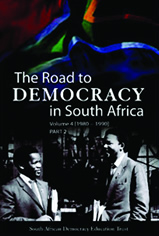 Volume 4 Part 2
Volume 4 Part 2
Chapter 17
Trade union unity summits and the formation of COSATU, 1980–1990
By Sifiso Ndlovu and Jabulani Sithole
Chapter 18
The arts in the 1980s: between states of emergency and transcendence?
By Bhekizizwe Peterson
Chapter 20
The ANC’s armed struggle in the 1980s
By Gregory Houston
Chapter 21
The South African Communist Party in the 1980s
By Eddy Maloka
Chapter 22
The PAC’s exile politics, 1980–1990
By Thami ka Plaatjie
Chapter 23
The PAC’s attempt at internal revival in the 1980s
By Thami ka Plaatjie
Chapter 24
The Azanian People’s Organisation, 1977–1990
By Mbulelo Vizikhungo Mzamane and Bavusile Maaba
Chapter 25
The Black Consciousness Movement of Azania, 1979–1990
By Bavusile Maaba and Mbulelo Vizikhungo Mzamane
Chapter 26
The origins of national organisation among civic organisations in South Africa, 1979–1990
By Jeremy Seekings
Chapter 27
Of faith and action: aspects of the role of faith institutions in the struggle against apartheid
By Siphamandla Zondi
Chapter 28
The story of the Christian Institute
By Cedric Mayson
Chapter 29
Visual artists in the struggle against apartheid (1980–1990)
By Brown Maaba and Narissa Ramdhani
Chapter 30
The rise and fall of constructive engagement
By Bernard Magubane
Chapter 31
Liberal democratic anti-apartheid activity within South Africa
By Chris Saunders
Chapter 32
The collapse of the garrison state
By Bernard Magubane
Book Launch : The Road to Democracy in South Africa, Volume 4, 1980–1990
ABRIDGED COVER
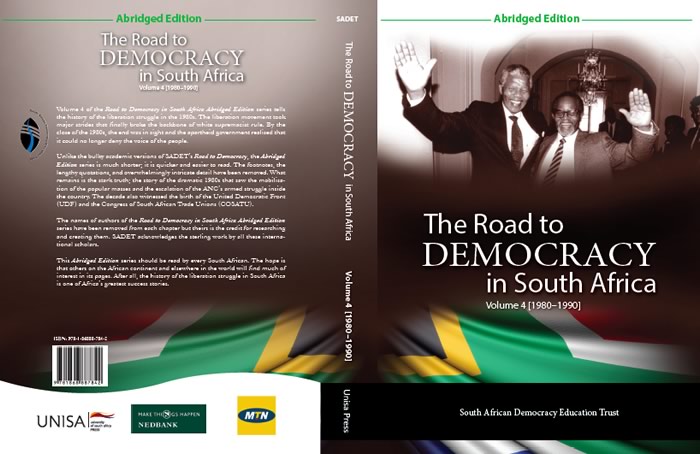
About Us | Road to Democracy | Gallery | Sponsers | Contact | Interviews | Home
© 2015 SADET - All Rights Reserved


